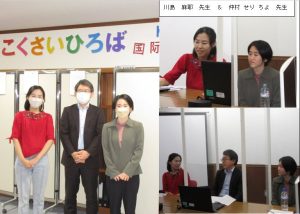Kokusai Hiroba Café -Around the World- Vol.73''Hawaii , USA & Mexico''
Kokusai Hiroba Café -Around the World- Vol.73「Hawaii (USA) & Mexico」
| Date |
8th January 2023 (Sun) 14:00 - 15:00 |
Venue | Online (Zoom) |
| Organizer |
Fukuoka International Exchange Foundation |
Entry Fee | Free |
| Participants |
26 people |
| Lecturers |
Seri Chiyo Nakamura (Hawaii) Aya Kawashima (Mexico) |
◇Contents
Opening(Introducing Hiroba Café)
Lecturers introduce Vietnam and Guinea
Question Time and Closing
(Opening)
The host introduced the work of the world Kenjinkai. He then introduced the presenters.
(Introducing each country)
Hawaii, as introduced by Lecturer Nakamura:
Lecturer Nakamura’s presentation covered various topics such as the origins of the 8 islands of Hawaii, the celebration for giving respect known as Lei Day, traditional hula dance which tells the story of Hawaii’s myths and legends, and finally Hawaii’s food culture. She explained in an easy-to-understand way, whilst showing photos and videos to the audience.
Lecturer Nakamura started off by explaining that the Hawaiian Archipelago is made up of 137 islands in total. The islands were formed from the remains of volcanoes, which came about due to Hawaii’s location, a ‘magma hotspot’ in the Pacific Ocean.
Moving onto the next topic, Lecturer Nakamura described how every year on the 1st of May, ‘Lei Day’ is celebrated in Hawaii. ‘Lei’, which is the name for wreaths which can be made from leaves, nuts, or various other types of natural foliage, symbolize respect. Therefore, on Lei Day, it is tradition to give ‘Lei’ to those that you respect, such as to the gods, family, and friends.
Also, Lecturer Nakamura showed a video of Hawaii’s hula dance, which is often used as a medium to teach the younger generations about the legends of Hawaii. In the video, the performers told the story of the goddess of fire and volcanoes, Pele, and they chanted her story along to the rhythm of drums.
Finally, Lecturer Nakamura showed examples of traditional Hawaiian food, such as kalua pork, which is traditionally cooked on a stove in the ground known as ‘imu’. However, she also conveyed that as well as these kinds of foods, Hawaii has also been influenced by foods all over the world and showed photos of unique examples of Hawaiian food which has been influenced by other cultures.
Mexico, as introduced by Lecturer Kawashima:
Lecturer Kawashima gave her presentation whilst wearing a Mexican-style blouse.
Her presentation described how Mexico is made up of northern Mexico, central Mexico, and southern Mexico, and the differences between them. She also gave an introduction to her hometown of Monterrey, as well as Mexico’s nature, food, and tourist attractions.
Mexico’s official name is the United Mexican States. One of the reasons for the name ‘Mexico’ is thought to be because the indigenous Mexica peoples historically lived there.
Next, Lecturer Kawashima introduced a traditional Mexican celebration, the Quinceañera, which is the commemoration of a girl’s 15th birthday. She also showed a video of the ‘guelaguetza’, a type of traditional dance.
Then, she introduced Mexico’s tourist attractions, including beautiful oceans, springs, and beaches, as well as heritage sites such as the ruins of Chichén Itzá, and the birthplace of tequila.
She then explained about Mexico’s 3rd biggest city, Monterrey. It is the birthplace of many Mexican companies, and its proximity to the US border means there are also a lot of international companies there too. Showing various photos, Lecturer Kawashima explained that the city is surrounded by mountains, so you can always see the mountains in every photo!
Among the many natural tourist attractions, Lecturer Kawashima introduced the ‘Cola de Caballo’, so named for being a waterfall which resembles a horse’s tail, and mountain ranges with dramatic ranges in height.
As for food culture, she explained, barbecues are very popular in Mexico, and it is common for people to come together for a barbecue when there is a soccer match, for instance.
Furthermore, in Monterrey there is the Museum of Contemporary Art, MARCO, and various other places where art, music, and design can be enjoyed.
Due to the influence of immigrants from Japan, there are also various Japanese companies in Mexico.
